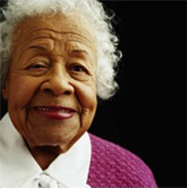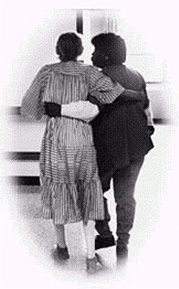Cultural Resources
 |
 |
 |
SENIORS, ELDERS, AND GRANDPARENTS DAY
CULTURAL RESOURCES
Sunday, September 11, 2011
Margarita Simon Guillory, Guest Cultural Resource Commentator
Doctoral Student in African American Religion, Rice University, Houston, TX
I. Introduction
| Old places and old persons in their turn, when spirit dwells in them, have an intrinsic vitality of which youth is incapable, precisely, the balance and wisdom that come from long perspectives and broad foundations. | |
| —George Santanyana |
In What Moves at the Margins, Toni Morrison discusses the place and presence of the African American elder. She speaks of the elder’s ever-presence in the novels of African American writers such as James Baldwin, Richard Wright, and Toni Cade Bambara. Morrison utilizes this presence as a scaffold to construct a definition of an elder. Elders, in her words, “are not just parents, they are sort of timeless people whose relationships are benevolent, instructive, and protective, and they provide a kind of wisdom.”1 Elders evade temporal boundaries. They are relational—constantly availing of themselves. They are a source of love, instruction, and protection. These defining predicates serve as sufficient reason to honor seniors, elders, and grandparents on this day.
Anne Streaty Wimberly, in her book Honoring African American Elders, discusses the importance of giving honor to elders in African American communities. For her, honor “means acknowledging the significance of the lives lived by elders and treating them as persons of worth.”2 Elders possess a wealth of life experiences that are invaluable for succeeding generations. These experiences include peaks, but they also include life’s troughs. It is within the valley times that today’s Scripture speaks. Elders have experienced stumbling moments throughout the course of their lives; however, their steps remained firmed because of the faithfulness of God. Their ability to attest to such faithfulness places them in a high position, one to be celebrated and praised by those they have nurtured over time. Like the psalmist, the stories of seniors, elders, and grandparents are worthy to be heard.
II. Their Stories Form and Reform Us
When the griots of West Africa opened their mouths, oral intonations of the community’s tradition, culture, and history vibrated the eardrums of all those surrounding them. Likewise, African American elders share their stories of trials, tribulations, and triumphs with fellow congregants during testimonial services. Both the African griot and the African American elder are storytellers. Their stories are verbal displays of multidimensional wisdom, political/social empowerment, and spiritual striving.3
Silence Under the ShedSpit on the Ground
I Must Take Care of the Babies
The central characters in each of these stories represent elders who have played a significant role in my life. The first story recalls the times that my grandfather and I sat under the shed for hours in silence. At the time, I did not understand his love for silence. However, as an adult, I have learned to cherish the silent moments of life, for quite often it is in the silence that some of life’s most valuable lessons are taught. The second story served as a guiding mantra for my great uncle Granville. He told me this story at least once a week for over a year before he passed away. It is this story that comes to mind when I am tempted to question my status as a world citizen because of my race and gender. I remember his words, “It’s the same; there is no difference. It’s all just spit on the ground.” Finally, the last story is a testament to my great Godmother. I have gleaned from her narrative the power of commitment to the next generation. She has taught me the inextricable relationship existing between nurturance and legacy. These stories of the elders, as stated in this moment’s Scripture, “are ever giving liberally and lending.” Accordingly, those like me who are generously blessed by such stories of our seniors, elders, and grandparents will forever serve as a blessing to the next generation. In this way, the legacy continues.
III. A Political Celebration of African American Elders
Although the preservation and presentation of narratives represent one way of honoring elders, the formation of organizations that forefront the needs of an aging community serves as an additional way to show an appreciation for seniors, elders, and grandparents. In 1995, former mayor of Seattle Norman B. Rice formed the Mayor’s Council on African American Elders (MCAAE). This twelve-member council advises the mayor, City Council, and Human Services department on matters relating to the diverse needs of elders of African descent in Seattle. The MCAAE operates according to a specific mission, purpose, and commitment:4
The MCAAE serve as an example of a council of elders who willingly give back their time and energy to the community to which they belong. Their faithfulness to the elders of various communities results in the meeting of the diverse needs—including health benefits, a measured amount of economic stability, and a continuation of education-concerning policies and practices affecting African American elders of Seattle. Although the MCAAE is a local organization that “models the Christian faith and teaches others how to be a blessing.”
IV. Senior Movements
The following organizations and programs exist to serve seniors. They are resources to help you better serve the seniors in your community.
1. The National Senior Citizens Law Center
In an increasingly complex social and technological world, seniors face numerous legal issues that most churches are not equipped to handle. The National Senior Citizens Law Center is an organization that has provided legal assistance to seniors for more than 35 years. Its profile and beliefs follow:
Through advocacy, litigation, and the education and counseling of local advocates, we seek to ensure the health and economic security of those with limited income and resources, and access to the courts for all.
Because we believe in publicly-funded safety net programs, we work to preserve and strengthen Medicaid, Medicare Part D, Social Security and SSI. To guarantee fair treatment, we work for greater access to federal courts for citizens and for better enforcement of consumer’s legal rights in safety net programs.
Vision
We envision an America in which elderly people and people with disabilities can live in dignity and safety and remain as independent as possible for as long as possible, where they are free from the worries and pain of poverty or the lack of health care, and they are able to contribute to their families and societies to the best of their abilities.
Our Beliefs
We believe that:
2. National Institute of Senior Centers
Since many African American churches operate full-time or part-time Senior Centers, the report by the National Institute for Senior Centers may be helpful in refining the operations of your center and/or in beginning a center. See the report “New Models of Senior Centers. “ Online location: http://aging.cprs.org/bass_lake/NMTF_Report_2009.pdf accessed 20 March 2011
3. The National Alzheimer’s Association
The association provides an array of services for persons suffering from Alzheimer’s and their families. Especially helpful is the search box that allows persons to find resources in their local community. Every church should have in its resource file information on local services available for persons with Alzheimer’s and caregivers of those with Alzheimer’s. Online location: www.alz.org accessed 20 March 2011
4. The National Institute for Health’s (Senior Health) Website
The National Institute for Health Senior Health website is the official federal government website developed by the National Institute on Aging (NIA) and the National Library of Medicine (NLM), both part of the National Institutes of Health (NIH). The website contains more than 50 areas of information to assist churches in helping their seniors stay healthy. If your church has seniors you should use this website. Online location: http://nihseniorhealth.gov/siteindex.html accessed 20 March 2011
V. Songs for This Lectionary Moment
Songs serve as space in which notions of life resonate in a lyrical format. For instance, the verses of “Precious Memories” symbolize lyrical remembrances of life moments of the past, while “Life’s Railway to Heaven” discuss the tumultuous periods of one’s life journey. Despite these trials displayed in the former song, the last song, “One More Day,” is filled with hopefulness and thanksgiving. All of these songs are meant to celebrate the lived experience of past, the present life, and those days in the near future of seniors, elders, and grandparents.
Precious Memories
Precious mem’ries, unseen angels,
Sent from somewhere to my soul;
How they linger, ever near me,
And the sacred past unfold.
Chorus
Precious mem’ries, how they linger,
How they ever flood my soul;
In the stillness of the midnight,
Precious, sacred scenes unfold.
Precious father, loving mother,
Fly across the lonely years;
And old home scenes of my childhood,
In fond memory appear.
Repeat Chorus
As I travel on life’s pathway,
Know not what the years may hold;
As I ponder, hope grows fonder,
Precious mem’ries flood my soul.
Repeat Chorus5
Life’s Railway to Heaven
Life is like a mountain railroad,
With an engineer that’s brave;
We must make the run successful,
From the cradle to the grave;
Watch the curves, the fills, the tunnels;
Never falter, never quail;
Keep your hand upon the throttle,
and your eye upon the rail.
Chorus:
Blessed Savior, Thou wilt guide us,
Till we reach the blissful shore.
Where the angels wait to join us
In Thy praise for evermore.
You will roll up grades of trial;
You will cross the bridge of strife;
See that Christ is your conductor
On this lightning train of life;
Always mindful of obstruction,
Do your duty, never fail;
Keep your hand upon the throttle,
And your eye upon the rail.
Repeat Chorus
You will often find obstructions;
Look for storms of wind and rain;
On a fill, or curve, or trestle,
They will almost ditch your train;
Put your trust alone in Jesus;
Never falter, never fail;
Keep your hand upon the throttle,
And your eye upon the rail.
Repeat Chorus
As you roll across the trestle,
Spanning Jordan’s swelling tide,
You behold the Union Depot
Into which your train will glide;
There you’ll meet the Sup’rintendent,
God the Father, God the Son,
With the hearty, joyous plaudit,
“Weary pilgrim, welcome home.”
Repeat Chorus6
One More Day
One more day, one more day,
I thank God just for one more day.
One more day, the Lord has made a way,
I thank God just for one more day.
One more chance, one more chance,
I thank God just for one more chance.
One more chance to do the best I can,
I thank God just for one more chance.7
Notes
1. Morrison, Toni. What Moves at the Margins: Selected Nonfiction. Jackson, MI: University Press of Mississippi, 2008. pp. 62–63.
2. Wimberly, Anne Streaty. Honoring African American Elders: A Ministry in the Soul Community. San Francisco, CA: Jossey-Bass Publishers, 1997. p. 5.
3. Guillory, Margarita Simon. “My Hands, Their Eyes,” unpublished work.
4. Seattle Gov. “Mayor’s Council on African American Elders.” http://www.seattle.gov/mcaae/ accessed 1 April 2011
5. Wright, J. B. F. and Lonnie B. Combs. “Precious Memories.” African American Heritage Hymnal. Chicago, IL: GIA Publications, 2001. #517.
6. Abbey, M. E. “Life’s Railway to Heaven.” African American Heritage Hymnal. #472.
7. Douroux, Margaret Pleasant. “One More Day.” African American Heritage Hymnal. #538.



